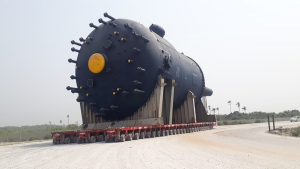Dangote Oil Refinery And Petro-Chemical Complex, Explained

Upon completion, the Dangote oil refinery will have the capacity to refine 650, 000 barrels of crude oil a day making it Africa’s biggest oil refinery and the world’s biggest single-train facility. It will also be producing fertilizer as well as other petrochemical products.
The facility is projected to create 70,000 jobs and save Nigeria 10 billion dollars in foreign exchange.
Currently, Nigeria is Africa’s top oil producer and oil is the government’s biggest source of revenue, about 70 percent of government revenue comes from oil.
Nigeria sits on an estimated 37 billion barrels of crude oil, but the country still relies on importing petroleum products due to a lack of functional refineries.
This is a quick look at how a single project can perhaps change an entire country’s fortunes and set it on a new path.
In 2013, Africa’s wealthiest man Aliko Dangote signed a multi-million dollar deal with banks to finance the building of his Dangote refinery and petrochemical complex.
Read more: Why Nigerians hate Big Brother Naija
Estimated to cost 12 billion dollars, the refinery will produce Euro-V quality gasoline and disel as well as jet fuel and polypropylene, the construction phase is expected to create 7,000 direct and another 25,000 indirect jobs.
It will be processing 650,000 barrels of crude oil a day which will be fractionally distilled into 50 million liters of petrol and 17 million liters of diesel as well as aviation fuel and plastic products. With greater capacity than the total output of Nigeria’s existing refining infrastructure, the Dangote refinery will be able to meet the country’s entire domestic fuel demands as well as export refined products.
The refinery site covers an area of 2,635 hectares on the Lekki Free Zone overlooking the Atlantic ocean. This location will enable the transshipment of products to the international market.
The processing facilities at the refinery will include a crude distillation unit and associated facility and a mild hydrocracking unit.

Other infrastructure features at the facility will include a pipeline system, access roads, tank storage facilities, and crude and product handling facilities.
In addition, an administrative building, guardhouses, and fire stations are parts of this facility.
The refinery complex also includes a fertilizer plant that will utilize the byproducts from the refinery as raw material.
The refinery facility will have an annual refining capacity of 10.4 million tones of petrol, in addition to 4.5 million tones of diesel and 4 million tones of jet fuel.
There is one more feature of this facility that most Nigerians and indeed people of West Africa will be most excited about, and that is it comes with the capacity to generate 12,000 megawatts of electricity. Nigeria currently generates about 6,000 megawatts of electricity and it sells a significant portion of that to other West African countries.
Dangote’s 12,000 megawatts should be enough to at least kick start Nigeria’s industrial revolution.
But not everyone is happy with this project, some have criticized its Lagos location. The refinery is being built hundreds of miles from the impoverished Niger-Delta where the bulk of Nigeria’s oil is extracted. Two undersea pipelines are under construction in the Delta and will carry crude oil about 340 miles to the refinery in Lagos.
The Dangote oil and gas refinery remains on track to be operational in early 2021 despite the disruptions caused by the Coronavirus pandemic. Yet critics worry that this will allow Mr. Dangote to essentially take over Nigeria’s oil and gas industry turning it into a monopoly.
Most Nigerians will choose a well-run monopoly over the current situation, where getting fuel remains an uncertainty.
